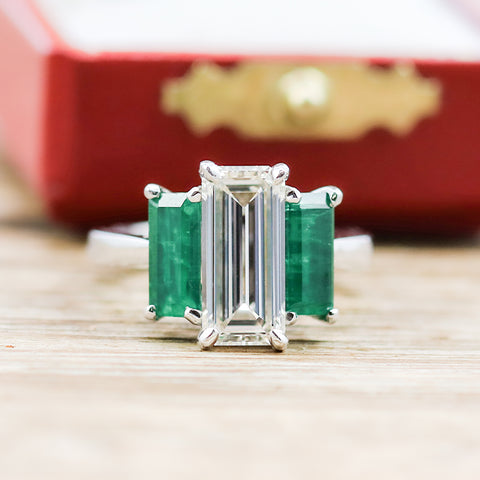
Emerald Cut
The Origin of the Emerald Cut and The Problem with Emeralds
Let’s go back to the 1500’s, a time when the lapidary industry was still coming to full terms with the rose cut. We’re centuries away from the glitz and glamour of the 18th century, and we’re certainly not able to create those beautiful lines like the steam powered bruting machine of the 19th century. We’re back to men cutting diamonds by hands, and in doing so having to be very careful about how they split a stone. It wasn’t just diamonds that were being deposited into their laps. One of the most difficult stones to work with (and perhaps for that reason one of the most sought out) was the notorious emerald.
If you’re going to understand why emeralds were considered such pains by lapidarists, you only have to look at the Mohs scale. The Mohs scale determines the hardness of a mineral, with a selection from 1 to 10. A “1” on the Mohs scale is Talc, a stone so soft it can be scratched by your fingernail. A “10” is a diamond, the hardest substance known to man. Emeralds register a hardness of “7”, which may sound pretty high, but the scale moves up exponentially, and that is still a hardness level that requires extra attention and care.
Another problem you’ve got with emeralds is that they have a tendency for inclusions. Based on nature and how they are mined (dynamite and collecting in river deposits), emeralds are among the rarest natural gemstones to find flawless on the inside. These inclusions can create weak points, which assists a stone’s tendency to break when hit at exactly the wrong angle.
For these reasons, when an emerald was put on someone’s table, it was a massive headache to cut without breaking it. In order to give an emerald facets, and thereby make it sparkle, lapidarists began to shave off the side in varying layers. The corners, a major concern for breakage as a weak point, were then clipped (even if only at the minimum), leaving behind a beautiful rectangle cut that allowed an emerald to sparkle without obliterating during the bruting process.
Transitioning the “Emerald Cut” to Diamonds
Most diamond cuts discussed up to this point were meant to give the diamond a sense of sparkle and “fire” which produces a natural rainbow-like reflection of color from the stone. The emerald cut could never achieve this, and for that reason it wasn’t as popular in a diamond until the 1920s when the Art Deco movement took off. Those classic straight lines, sharp edges and mesmerizing symmetry, combined with a sense of innovation and creativity from seeing beauty where it was once ignored is a perfect metaphor for the Art Deco style of the 1920s and 30s. The term “emerald cut” actually was not even coined until it became so popular in the 1920s.
A Modern Emerald Cut Diamond
A modern emerald cut diamond tends to have an elongated rectangular shape with cut corners. It usually consists of 57 facets and the steps going down the girdle give the stone a unique “Hall of Mirrors” style sparkle, which is a tremendous contrast to the blinding sparkle of a modern round brilliant.
With step cut stones such as an emerald cut, the attractiveness of different proportions essentially falls down to personal preference. That said, most emerald cut diamonds will have a length to width ratio between 1.30 and 1.50, with 1.40 traditionally being considered “ideal”. Just like when they became popular in the 1920s however, there has been a trend shifting towards appreciating some emerald cuts that do not fit into this range, particularly when it comes to extra elongated emerald cuts.
One of the largest “downsides” to the emerald cut diamond also happens to be one of its largest upsides: seeing into the stone. This means that inclusions are much more visible to the naked eye, but it also means you can get lost gazing into a stone and admiring its purity when there are no noticeable inclusions. Because of this, most emerald cut diamonds tend to be cleaner stones, while the more included stones would be more likely to be cut into brilliants, whose facets do a much better job of hiding the inclusions.
Important Emerald Cut Diamonds
Due to the ease at which you can look into and become mesmerized by an emerald cut diamond, a lot of significant diamonds have been fashioned in an emerald cut, even though it is a relatively new cut. Some of these diamonds include the 160.18 “Table of Islam” black diamond, the “Uncle Sam” diamond (the largest diamond found in the USA – 40.23ct), the 108.81ct (D, IF) Mouawad Magic diamond, the 105.52ct "Star of Egypt" diamond, and the 25.27ct D, VVS2 Type IIa Jonker #5 diamond. Some celebrities who have chosen to get engaged with an emerald cut diamond include Beyonce, Heidi Klum, Nicola Peltz (current daughter-in-law of Victoria and David Beckham), Eva Longoria, Amal Clooney, Nicole Kidman, Angelina Jolie, Jennifer Lawrence, and the most famous of all, the Princess of Monaco, Grace Kelly.

 2.31ct G, VVS1 Emerald Cut Diamond
2.31ct G, VVS1 Emerald Cut Diamond Unique Elongated Emerald Cut Diamond Ring with Emerald Accents
Unique Elongated Emerald Cut Diamond Ring with Emerald Accents